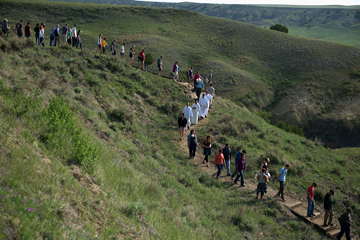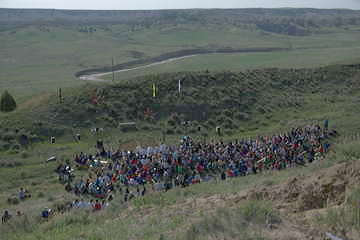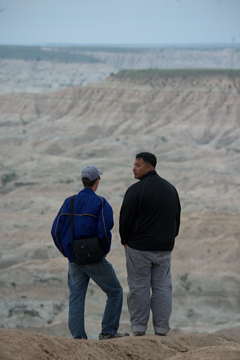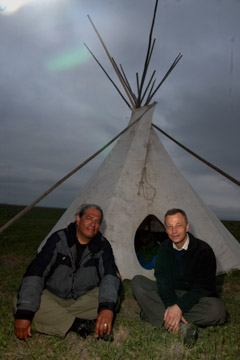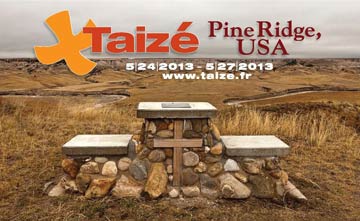The Pine Ridge gathering was the result of several years of reciprocal visits between South Dakota and Taizé. Last December, a large group of native and non-native youth came to the European meeting in Rome. Gradually, trust was built and the dream of organizing something on the Pine Ridge reservation became a reality. The Two Bulls family in Red Shirt offered to welcome pilgrims to their home. In April, two brothers went to the reservation to live and were then joined by others. In early May, three teams of brothers and young people undertook a pilgrimage throughout the state, visiting churches both on reservations and in cities for evenings of prayer and reflection.
Preparations for the meeting brought together different denominations and churches. The Episcopal Church has historically been very present on the reservation and in ministry with the Lakota, and without the spiritual and material support of the diocese and its bishop the meeting would not have been possible. The brothers were offered warm hospitality by a community of Jesuit priests who run a school at Red Cloud, and the Catholic bishop of Rapid City attended part of the meeting. Lutheran and Presbyterian retreat centers, as well as a small non-denominational community in Rapid City, helped house volunteers during the time preceding the meeting. A host of churches, families and individuals gave generously of their time and energy to make the gathering possible.
Relations between natives and non-natives in that part of the United States are not without problems, due to the complex history of their interactions. Prejudices still abound. “A Church group made a report on our reservation a few years ago, said one person from the Crow Creek Reservation. They called us ‘poor’. We were shocked because we never thought of ourselves as poor. In our culture, money was never a standard by which to measure wealth. We are rich. We have a rich culture. We have much to share.” A woman from the Pine Ridge Reservation, a pillar of hope in her local church, told one of the brothers: “The lack of self-esteem we suffer from will not be solved overnight. It will take years to change. We must accept that and work towards that goal.”
Visits to the reservations for purposes of tourism, or by Church groups or non-profit organizations seeking to offer assistance, are fairly common, but the idea of simply being welcomed by local people in order to live and search together seems never to have been attempted. Perhaps surprisingly, the idea was almost immediately understood by the Oglala Sioux tribe and its leadership, who strongly supported the gathering, among other things by offering two buffalo which served to feed participants in the course of the weekend. One participant from Canada thanked the native family that hosted the gathering: “Thank you for trusting our intentions. So often people with good intentions have caused more suffering. Thank you for daring to trust once again, in spite of the past.”
The meeting itself followed the usual pattern of the pilgrimage gatherings, adapted to the local situation. Participants stayed in tents, and prayed together three times a day in a natural outdoor amphitheater. On Saturday, there were two bible introductions followed by small-group sharing as well as a dozen different workshops. On Sunday, participants shared the worship of various local churches and, in the afternoon, chose from among four “field trips” to different locations. The largest group went to visit Wounded Knee, site of a notorious massacre in 1890 and demonstrations in the 1970s, for a time of silent prayer, led by a team of young adults, both native and non-native. In the evenings, there were group sessions under a large tent, involving reflections by native leaders and Brother Alois and Lakota cultural presentations. One evening, Brother Alois presented the tribe with a piece of pottery from Taizé, made entirely out of earth from the region of Burgundy. “We wanted to bring a piece of our land to your land,” he said. “But this pot is empty. You have to fill it. We did not come to bring a message or to give you advice. We want to share our gifts and listen to your words, and build a relationship.”
Pictures by Walter Wayman
The hope is that the relationships created will continue in the coming months and years; already a group from the area is planning a return visit to Taizé.
 TAIZÉ
TAIZÉ